
In-depth: The challenge of using biofuels to cut transport emissions
Jocelyn Timperley
07.19.17Jocelyn Timperley
19.07.2017 | 8:00amLiquid biofuels still have a significant role to play in meeting the UK’s climate change targets, a new report says.
The Royal Academy of Engineering analysis, commissioned by the UK Department for Transport (DfT) and now-defunct Department of Energy and Climate Change (DECC), reviews the most significant sustainability issues associated with the use of biofuels.
It argues that some biofuels can help the UK to meet the greenhouse gas emissions savings required under EU and UK rules.
They also offer potential options for cutting emissions in tricky-to-decarbonise transport sectors, such as aviation, shipping and heavy goods vehicles (HGVs), it says.
But the report cautions that the use of biofuels can in some cases result in problems, such as knock-on emissions due to land-use change, degradation of land and increases in food prices.
Sensible policies can minimise these downsides by promoting the use of non-food crops and wastes to produce biofuels and disincentivising feedstocks linked to unsustainable land-use change, the report says.
Carbon Brief breaks down the main findings of the report, which provides an overview of the current status of biofuels in the UK.
Policy context
![]()
Over the past decade there has been a rising interest around the world in biofuels as a means to cut transport emissions. More than 60 countries have now launched biofuel programmes and set targets for blending biofuels into their fuel pools.
In the UK, transport accounted for 29% of CO2 emissions in 2015, the second-largest source after electricity generation. Emissions in this sector have barely changed since 1990.
Back in 2008, the UK introduced the Renewable Transport Fuel Obligation (RTFO), its main mechanism for supporting the supply of renewable fuels in transport.
This required 2.5% of total road transport fuel to come from biofuels in 2008/09, with the proportion increasing to 4.75% by 2013. It applies to all firms who supply more than 450,000 litres of road transport fuel per year to the UK market.
This is especially a worry for so-called first-generation biofuels, which are those produced from food or animal-feed crops, such as wheat or soy, rather than from energy crops or waste.
- First generation biofuels are those produced from food and animal crops. They are used to replace fossil fuels and cut emissions. However, there are significant concerns their use could lead indirectly to higher emissions, such as by indirectly increasing deforestation.
- Biofuels are often separated into two other buckets: second and third generation.
- Second generation or “advanced” biofuels are those produced from sources which cannot be used for food. These include dedicated energy crops, such as miscanthus, agricultural and sawmill residues, wood wastes, and used cooking oil.
- The Royal Academy of Engineering assessment of over 250 separate studies finds these tend to have a greater potential than first-generation biofuels to reduce greenhouse emissions, although this is only the case if there is no land-use change.
- Third-generation biofuels, sometimes also referred to as advanced biofuels, are those produced from algae. According to the report, at their present state of development, these aren’t a viable option: their emissions are currently higher than those from fossil fuels and they are not economic to produce. Algae production is likely to remain restricted to high-value products, such as cosmetics, dietary supplements or speciality chemicals, for some time, the report found.
The RTFO was expected to be extended to mandate a 10% share for biofuels by 2020, in line with the EU’s 2009 Renewable Energy Directive (RED). This requires a minimum 10% share of renewable energy in member states’ transport sectors by 2020.
However, significant concerns have emerged that the production of biofuels can lead to land-use changes – such as deforestation – which reduce emissions savings, and even in some cases increase emissions above those of the fossil fuels alternative. There are also concerns that the growth of biofuel feedstocks can increase the degradation of land, water resources and ecosystems.
Alongside the disquiet over uncertain emissions savings, there have also been concerns that the use of food crops to produce biofuels could lead to higher agricultural commodity prices. The report notes there is so far little agreement on the magnitude of this problem and its relationship with food security. On the other hand, biofuel markets could also be used as a balance to absorb surplus production of food-crops in normal years and provide a cushion in years of unexpected supply disruptions.
Dwindling interest
For all these reasons, enthusiasm amongst policymakers for increasing the use of biofuels has waned. This was especially the case after a 2008 government-commissioned review by Prof Ed Gallagher, a former Environment Agency chief executive, recommended that targets higher than 5% should only be implemented if emissions from land-use change are avoided. The target in the UK currently remains at 4.75%, far short of the 10% mandated by the EU for 2020.
The Committee on Climate Change (CCC) has also advised caution to ensure biofuels achieve real emissions savings on a lifecycle basis, saying that biofuels’ role in transport should be limited in the long term. However, it has recommended the government should raise biofuels’ share of road-fuel energy to 8% by 2020 and 11% by 2030.
Since the market for biofuels is driven by the legal requirement to blend them into road transport fuel, the current reluctance to increase RTFO as previously expected has caused financial difficulties for UK biofuel plants, the Royal Academy of Engineering report notes.
While the UK maintains an overall commitment to increase biofuels in its energy mix, its use of biofuels has actually slightly decreased since 2013/14, as the graph below shows. Liquid biofuels currently make up about 3% of total transport fuel supplies in the UK (note that the 4.75% biofuel target applies only to road transport fuel).
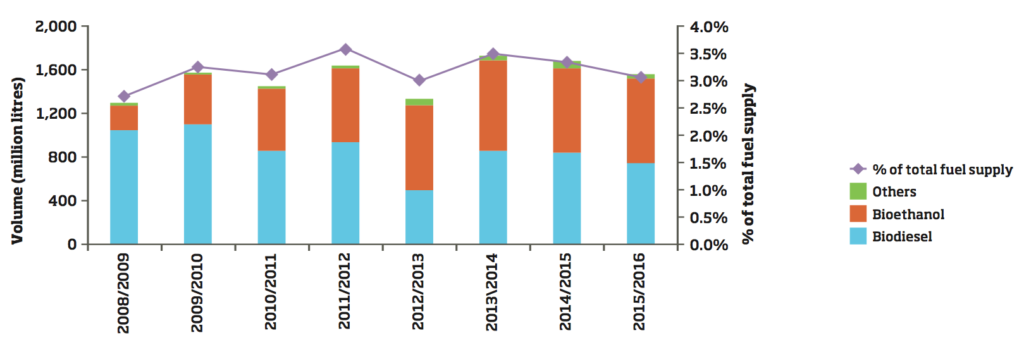
Supply of biofuels in the UK by fuel type. Source: Royal Academy of Engineering, Sustainability of liquid biofuels, based on 2017 biofuels data from the Department for Transport.
The difficulty with biofuels
![]()
The challenge with biofuels is their complexity, the new Royal Academy of Engineering report says. Their carbon footprint depends on everything from changes in soil carbon content over time to the evolution of global supply chains.
The biggest worry with biofuels is indirect land use change (ILUC), whereby switching to biofuel production in one place can result in large greenhouse gas emissions many miles away.
Speaking to journalists ahead of the launch of the report last week, co-author of the report Roger Kemp, professorial fellow at Lancaster University, said:
“Switching to biofuel production in one place can result in large emissions of CO2 many miles away, and the results are likely to be different for different countries and different fuel crops. Needless to say, these calculations are complicated and there’s no general agreement on what to take into account, or how far back you go up the food chain.”
The graph below shows the carbon footprint of bioethanol produced from a variety of food crops in different locations across the world, in situations either with or without direct or indirect land use change (LUC). The vertical spread represents the range of different results, which also depend on the study methodology. The graph compares the emissions savings to those required under current EU rules.
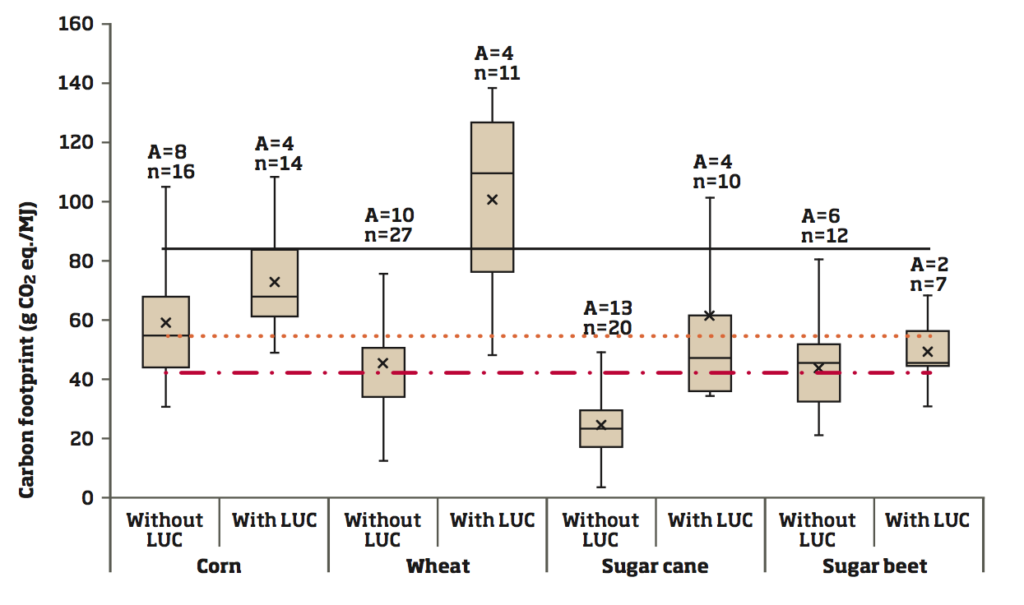
Carbon footprint of first-generation bioethanol with or without land-use change (LUC). The chart includes the reference carbon footprint of petrol (black line); the minimum 35% emissions saving required by the EU until 2016 (red dotted line); and the 50% saving required now (red dashed line line). Source: Royal Academy of Engineering, Sustainability of liquid biofuels based on a meta-analysis of 41 separate biofuels studies.
The results show that land-use change, if it occurs, significantly increases the carbon footprint of biofuels.
Importantly, carbon savings in many cases fall short of the 50% EU requirement. Some studies found wheat-based biofuel to have even higher emissions than the petrol it replaces, if its production causes land-use change.
The analysis indicates that only sugar cane can be reliably expected to meet the 50% threshold – and then only if it avoids land-use change. Wheat and sugar beet are able to meet the target in some circumstances or geographies, while the meta-analysis suggests corn-based biofuel cannot reduce emissions enough to meet the 50% threshold.
It’s worth noting that the differences between the different crops (such as the high carbon footprint of wheat with LUC) are likely related to particular land-use change where the crop is generally grown rather than an inherent characteristic of that particular crop.
The range of carbon footprints calculated for bioethanol derived from non-food, second-generation crops is shown in the chart, below.

Carbon footprint of second generation bioethanol. The chart includes the reference carbon footprint of petrol (black line); the minimum 35% emissions saving required by the EU until 2016 (red dotted line); and the 50% saving required now (red dashed line line). Source: Royal Academy of Engineering, Sustainability of liquid biofuels based on meta-analysis of around 31 separate biofuels studies.
It shows far larger greenhouse gas savings are possible than for first-generation, food-based biofuels. However, it’s worth noting again that the results represent a large variety of feedstocks, production routes, technology assumptions and methodological differences: for instance, some studies considered emissions from ILUC while others did not.
The report also notes that most studies of biodiesel from used cooking oil (UCO), commonly used in the UK, find its carbon footprint is 60% to 90% lower than conventional diesel.
Co-author of the report Adisa Azapagic, professor of sustainable chemical engineering at the University of Manchester, told journalists:
“In general, second-generation [non-food] biofuels have a greater potential than first-generation biofuels to reduce greenhouse gas emissions, again provided there is no land-use change. Therefore, the shift in policy away from first- to second-generation biofuels is a positive policy development and should be incentivised further.”
However, the report also notes that low oil prices mean the economic viability of some second-generation biofuels remains doubtful in the current economic context.
Policy future
There has been a lengthy debate at EU level on how to address indirect land-use changes as a result of biofuels, with some organisations, such as Friends of the Earth, calling for a complete phase out of the use of food crops for biofuels.
Amendments made to EU policy have set more stringent criteria for the biofuels used to meet national targets. These include a rise in the minimum greenhouse gas emissions savings compared to fossil fuels from 35% to 50% in January 2017 and the exclusion of biofuels grown on land with peat or high carbon stocks.
The EU has also put a 7% cap on the proportion of transport energy from crops grown on agricultural land that can be counted towards its 2020 renewable energy targets.
Further proposed revisions announced by the European Commission in November 2016 would reduce this cap to 3.8% in 2030. This development has been criticised by the biofuel industry for undermining investments in biofuels and NGOs for doing too little to phase out food-based biofuels in favour of the electrification of transport.
The proposals would also raise the minimum greenhouse gas savings over fossil-fuel alternatives to 70% by 2021 and set a sub-target for advanced biofuels starting at 0.5% of energy consumed in road and rail in 2021 and rising to 3.6% in 2030.
The UK has continued to support the development of biofuels to some extent.
For example, in 2015, the government awarded £25m to three projects to demonstrate and scale-up second or third generation biofuels. A further £20m was announced in late 2016 targeting the decarbonisation of HGVs and aviation with “advanced renewable fuels”.
Meanwhile, the DfT last year ran a consultation on changes to the RTFO, including plans to set a lower UK cap on crop-based biofuels than the 7% set by the EU in 2015 and to do more to ensure that wastes eligible for additional reward are genuine wastes.
The new report largely welcomes these proposals. However, the government has made no announcements on bringing in the changes since the consultation closed in January 2017.
The UK has also yet to clarify whether it will continue to apply EU biofuels rules post-Brexit, although it will to continue to follow these regulations until it actually leaves the EU.
Part of the mix
The new report also argues that the UK will have to use all possible low-carbon technologies and fuels – including biofuels – if it is to hit its Climate Change Act target of an 80% reduction in greenhouse gas emissions by 2050.
The currently anticipated widespread adoption of electric vehicles, when combined with decarbonisation of the electricity system, will in time reduce emissions from cars and light vans. But the report says there are likely to be fewer alternatives to fossil fuels for other forms of transport, such as aviation, shipping and HGVs, at least for several decades.
These areas should, therefore, be the focus for long-term biofuel use, the report’s authors say. However, little progress has so far been made in these sectors.
In aviation, the main constraint is the need for easily mixable fuels that meet the sector’s high-performance specifications.
Fuel specifications are somewhat less stringent in shipping, but biofuels are currently not used for marine shipping in the UK. This is because fuel choice is mainly driven by price, availability and speed of loading, the report notes. Biofuels can also create challenges due to the need to store the fuel onboard for long periods.
There are also technical challenges to using biofuels in HGVs, which are likely to continue to be powered by diesel for the foreseeable future rather than electrified, the report says. For instance, trials have shown some HGV engines may be incompatible with high blends of biodiesel, while the use of biofuels may in some cases lead to higher component wear or lower miles per gallon. The latter issue is particularly significant as fuel costs dominate the operating costs of HGVs.
Biofuels around the world
The current stagnation of biofuels growth in the UK comes at a time when worldwide production has continued to rise. Bioethanol production increased threefold to 98bn litres between 2005 and 2015, while biodiesel production increased almost eightfold to 30bn litres.
The chart below shows the rise in biofuel production over the past ten years. Note that hydrotreated vegetable oil (HVO) is a form of biodiesel produced from vegetable oils and fats by treating them with hydrogen, rather than methanol as for other biodiesel.

Global trends in bioethanol fuel (yellow), biodiesel (orange) and hydrotreated vegetable oil (HVO; brown) production from 2006 to 2016. Source: REN21, Renewables 2017
Globally, around 4% of transport fuels are now biofuels, which currently make up the vast majority of the renewable energy contribution to the transport sector.
Around 0.8% of the world’s total energy supply came from biofuels in 2015, according to the REN21 report released last month on the global status of renewables.
The US and Brazil dominate the world’s production of biofuels, together producing almost three quarters of the global total in 2015, largely from corn and sugarcane.
Where do the UK’s biofuels come from?
According to the REN21 report, the UK produces less than 2% of the world’s biofuel. Around three quarters of the biofuel used in the UK is imported.
As the map below shows, the biggest suppliers of UK biofuel are the UK itself, France, Spain, the US and the Netherlands (note that Rotterdam is Europe’s largest port for the import of biodiesel and ethanol, therefore, much of the Netherlands’ supply to the UK is likely to have originated elsewhere).
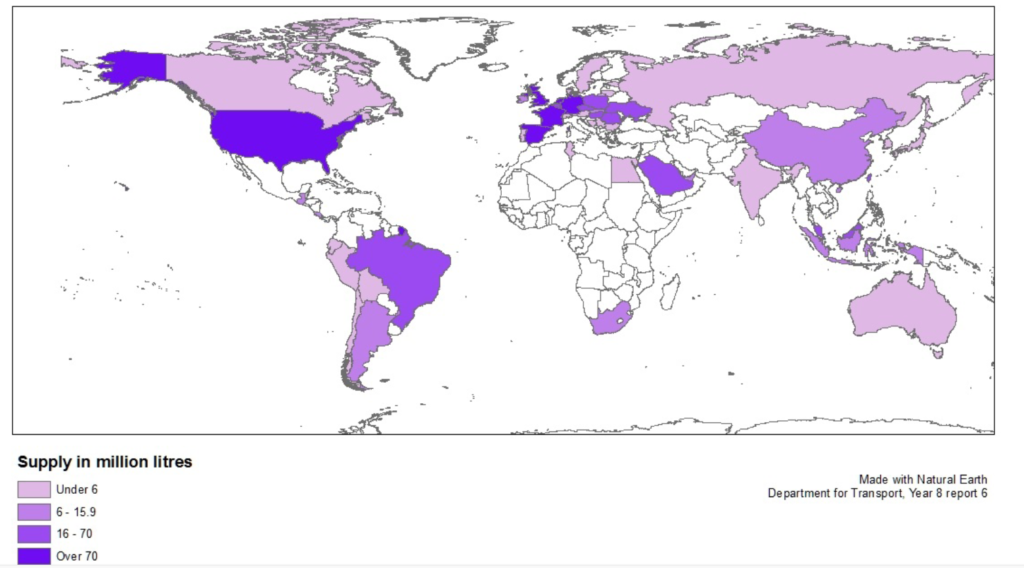
Global supply of biofuel to the UK in 2015/2016. Source: Department of Transport, Biofuel statistics Year 8 (2015 to 2016), report 6.
It’s worth noting that transport of feedstocks or biofuels can add significantly to their carbon footprint. Shipping adds between 7% and 38% to the total carbon footprint of biofuels transported over 10,000km, the report says.
Most of the biofuel used in the UK is made from wheat (for bioethanol) and used cooking oil (UCO; for biodiesel). The chart below shows the sources of the UK’s domestic and imported supplies of biofuel. The use of biofuels derived from wastes, such as UCO, is particularly high in the UK compared to other countries, while the proportion from corn has fallen in recent years.
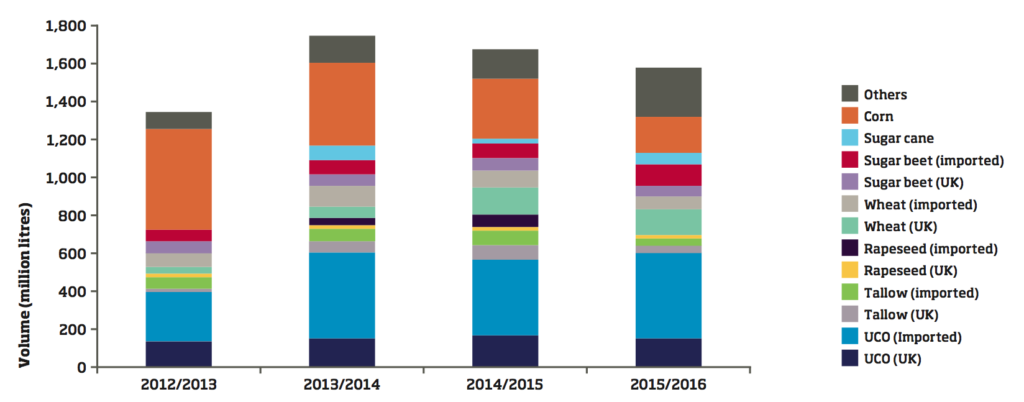
Supply of biofuel in the UK by feedstock type. Source: Royal Academy of Engineering, Sustainability of liquid biofuels, using data from REN21, Renewables 2017 Global Status Report.
This prevalence of UCO in the UK has been driven in part by EU “double counting” rules, which allows fuel suppliers to reach their blending obligations with half the amount of biofuel if it comes from waste or other non-food biomass. The new report recommends the UK retains this principle as a way to drive the adoption of second-generation biofuels.
One 2014 report estimated the UK has a potential annual domestic supply of nearly 16m tonnes of various types of waste, which could be used to produce around 3bn litres of biofuel – roughly twice what the UK currently uses. Green waste (such as garden waste), agricultural straw and waste paper together make up over four-fifths of this.
However, it’s important to note that some of this waste is avoidable, or has competing uses, such as the production of heat and power, or compost.
Meanwhile, the UK currently only produces very small amounts of dedicated biofuel energy crops.
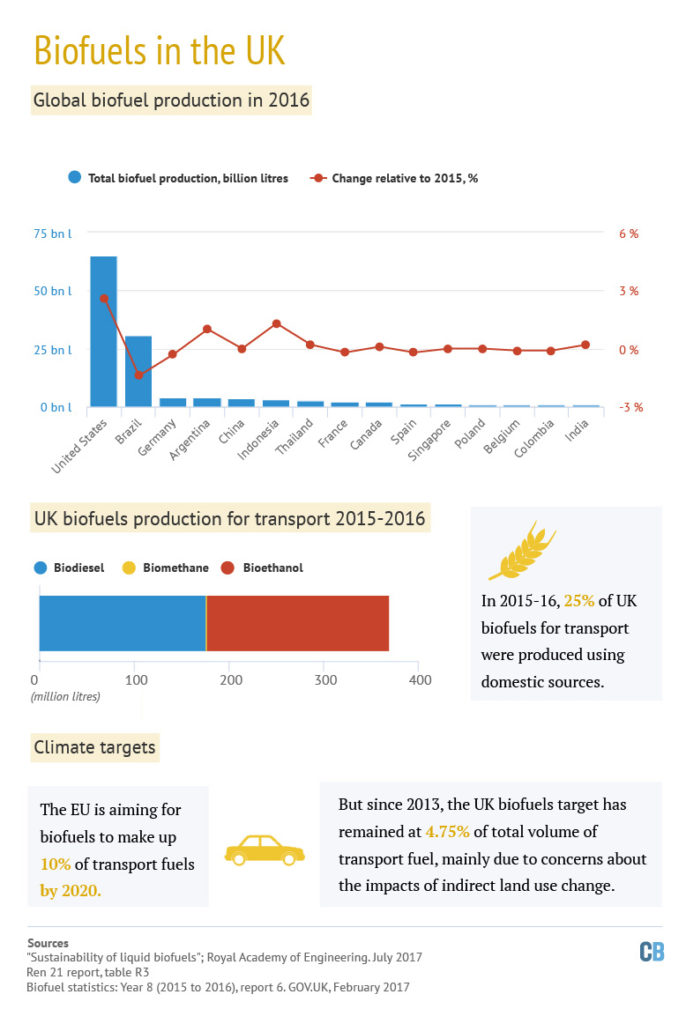
Biofuels in the UK. Infographic by Rosamund Pearce for Carbon Brief. The UK part of this infographic was updated in January 2018 to reflect a mistake made in the REN21 source data, which incorrectly indicated the UK produces large amounts of hydrogenated vegetable oil. This has now been updated with data from the UK government.
Where to go from here
The report brings together a wide range of estimates from different studies on the future of biofuels. Some of these suggest that as much as one-third of global transportation fuel could come from biofuels by 2050, while others predict more modest potential.
For example, the International Energy Agency (IEA) “technology roadmap” considers biofuels might constitute around 27% of global transport fuel supply in 2050, while the OECD and BP project a 7% share for biofuels by 2030.
But, as the report warns, any increase in biofuels must only be made if a risk-based approach is taken to ensuring the use of biofuels cuts greenhouse gas emissions.
Alongside incentivising development of lower-risk, second-generation biofuels, the report supports the setting of a more stringent cap for supply of crop-based biofuels, in order to reduce the risk of indirect land-use change.
It also recommends incentives to ensure that, where possible, marginal land not suited for food production is used to produce biofuels from energy crops. It also pushes for audit and certification schemes to be strengthened to ensure the local situation is taken into account.
In the case of biofuels made from wastes and residues, meanwhile, it argues clear and consistent categorisation is needed to avoid unintended market distortions.
Conclusion
The UK continues to hesitate over the use of biofuels to decarbonise the transport sector, although plans to further increase the use of waste rather than food crops to produce them could open the door to higher targets.
This new report says the UK government should step up action to increase the use of biofuels in transport, in order to tackle emissions. The analysis argues there are enough raw materials to make biofuels in the UK and to increase the blending obligation to 10% within five to ten years.
This timeline would see the UK missing the EU 2020 target of 10% supply of biofuels in the road transport fuel mix by several years, whether or not the goal continues to apply after Brexit.
Importantly, the authors also argue that the future development of biofuels needs to be adjusted, depending on how the UK energy system develops over the coming years.
For example, the report says a rapid growth of windfarms could result in surplus electricity, which could be used to produce hydrogen. This is a competing low-carbon fuel which could, in the longer term, reduce the need for biofuels.

